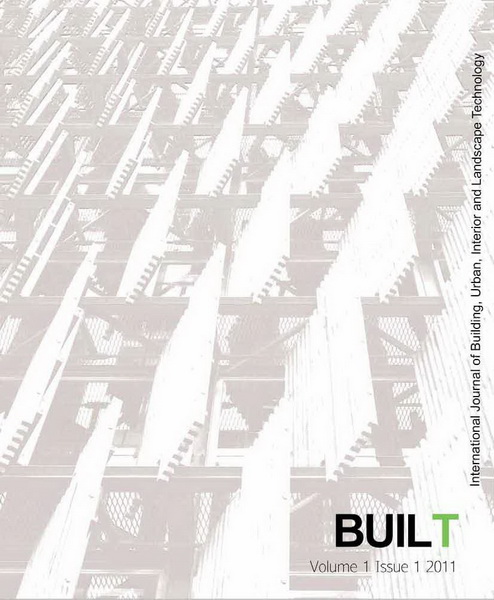Integrative Passive Design for Climate Change: A New Approach for Tropical House Design in the 21st Century
DOI:
https://doi.org/10.56261/built.v1.170307Keywords:
Passive design, Natural ventilation, Thermal mass, Evaporative cooling, Climate change, Tropical houseAbstract
This article presents a new approach to passive building design which takes intoaccount the impacts of climate change. The approach involves considering the relative performance of a range of low-energy, passive design alternatives under a projected future climate. A low-cost housing project in the hot-humid tropics of Thailand is used herein todemonstrate the application of this new design approach. Theoretical analysis is carried out and shows that if the potential changes in the ambient temperature, solar radiation and humidity driven by climate change are taken into account, a combination of a number of passive design techniques, including passive cooling, is likely to be required to achieve interior thermal comfort and energy efficiency in these houses. To eliminate the requirementfor air-conditioning, the houses should be laid out in a staggered fashion on the plot tomaximize airflows between the houses. Each house would also benefit from having its service areas (e.g. kitchen and bathroom) located on the west side to act as a thermal buffer for its main spaces (e.g. bedroom and living room). A combination of a double roof and shaded double façades would also be advisable to provide effective protection from strong solar radiation. The use of thermal mass in conjunction with passive evaporative cooling and natural ventilation would help further to provide the cooling needed in more extreme weather. The analysis shows that, with all the above techniques in place, up toa 95 per cent reduction in energy use for cooling could be achieved in the passive house, compared to the energy used in a typical air-conditioned house operating in the same conditions, while achieving a comparable level of comfort. A discussion on how to generalizethis new design approach to houses in different settings is provided.
Downloads
References
Auliciems, A. (1981). Towards a psycho-physiological model of thermal perceptions. International Journal of Biochemistry, 25, 109-122.
Auliciems, A., & Dedear, R. (1986). Air conditioning in a tropical climate: Impacts upon European residents in Darwin, Australia. International Journal of Biometeor, 30(3), 259-282.
Chenvidyakarn, T. (2009). PasCal (v.1.0) [Computer soft- ware]. Retrieved October 13, 2009, from http://www.arct.cam.ac.uk/Arct/ResearchGroup.aspx?p=23&ix=99&pid=14&prcid=5&ppid=1293
Gagge, A. P., Fobelets, A. P., & Berglund, L. G. (1986). A standard predictive index of human response to the thermal environment. ASHRAE Transactions, 92(2), 709-731.
Givoni, B. (1994). Passive and low energy cooling of buildings. New York: John Wiley & Sons.
Thailand Department of Energy Development and Renewable Energy. (2008). โครงการการศึกษาสถานภาพการใช้พลังงานและแนวทางการส่งเสริมการอนุรักษ์พลังงานในบ้านที่อยู่อาศัย [A study on the conditions of energy consumption and guidelines to promote energy conservation in the residential sector]. Retrieved September 15, 2008, from http://www2.dede.go.th/new-homesafe/webban/actionplan.htm
The Intergovernmental Panel on Climate Change. (2007a). Contribution of working group I to the fourth assess- ment report of the intergovernmental panel on climate change, 2007. Cambridge, UK and New York, USA: Cambridge University Press. Retrieved August 10, 2009, from http://www.ipcc.ch/publications_and_data/ar4/wg1/en/contents.html
The Intergovernmental Panel on Climate Change. (2007b). Contribution of working group III to the fourth assess- ment report of the intergovernmental panel on climate change, 2007. Cambridge, UK and New York, USA: Cambridge University Press. Retrieved August 10, 2009, from http://www.ipcc.ch/publications_and_data/ar4/wg3/en/contents.html
Khedari, J.,Yamtraipat, N., Pratintong, N., & Hirunlabh, J. (2000). Thailand ventilation comfort chart. Energy and Buildings, 32, 245-249.
Szokolay, S. V. (2004). Introduction to architectural science: The basis of sustainable design. Oxford, UK: Architec- tural Press.
Tantasavasdi, C., Srebric, J., & Chen, Q. (2001). Natural ventilation design for houses in Thailand. Energy and Buildings, 33, 815-824.
US Department of Energy. (2009). Statistics for THA_ Bangkok_IWEC. Retrieved September 1, 2009, from http://apps1.eere.energy.gov/buildings/energyplus/weatherdata/2_asia_wmo_region_2/THA_Bangkok_IWEC.stat
Downloads
Published
How to Cite
Issue
Section
License

This work is licensed under a Creative Commons Attribution-NonCommercial-NoDerivatives 4.0 International License.












